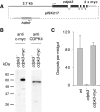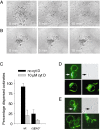Plasmodium berghei calcium-dependent protein kinase 3 is required for ookinete gliding motility and mosquito midgut invasion
- PMID: 16796674
- PMCID: PMC1513514
- DOI: 10.1111/j.1365-2958.2006.05189.x
Plasmodium berghei calcium-dependent protein kinase 3 is required for ookinete gliding motility and mosquito midgut invasion
Abstract
Apicomplexan parasites critically depend on a unique form of gliding motility to colonize their hosts and to invade cells. Gliding requires different stage and species-specific transmembrane adhesins, which interact with an intracellular motor complex shared across parasite stages and species. How gliding is regulated by extracellular factors and intracellular signalling mechanisms is largely unknown, but current evidence suggests an important role for cytosolic calcium as a second messenger. Studying a Plasmodium berghei gene deletion mutant, we here provide evidence that a calcium-dependent protein kinase, CDPK3, has an important function in regulating motility of the ookinete in the mosquito midgut. We show that a cdpk3- parasite clone produces morphologically normal ookinetes, which fail to engage the midgut epithelium, due to a marked reduction in their ability to glide productively, resulting in marked reduction in malaria transmission to the mosquito. The mutant was successfully complemented with an episomally maintained cdpk3 gene, restoring mosquito transmission to wild-type level. cdpk3- ookinetes maintain their full genetic differentiation potential when microinjected into the mosquito haemocoel and cdpk3- sporozoites produced in this way are motile and infectious, suggesting an ookinete-limited essential function for CDPK3.
Figures




Comment in
-
Be in motion . .Mol Microbiol. 2006 Jun;60(6):1327-8. doi: 10.1111/j.1365-2958.2006.05192.x. Mol Microbiol. 2006. PMID: 16796671
Similar articles
-
A calcium-dependent protein kinase regulates Plasmodium ookinete access to the midgut epithelial cell.Mol Microbiol. 2006 Feb;59(4):1175-84. doi: 10.1111/j.1365-2958.2005.05014.x. Mol Microbiol. 2006. PMID: 16430692
-
Essential role of membrane-attack protein in malarial transmission to mosquito host.Proc Natl Acad Sci U S A. 2004 Nov 16;101(46):16310-5. doi: 10.1073/pnas.0406187101. Epub 2004 Nov 1. Proc Natl Acad Sci U S A. 2004. PMID: 15520375 Free PMC article.
-
PbGCbeta is essential for Plasmodium ookinete motility to invade midgut cell and for successful completion of parasite life cycle in mosquitoes.J Biochem. 2006 Nov;140(5):747-57. doi: 10.1093/jb/mvj205. Epub 2006 Oct 9. J Biochem. 2006. PMID: 17030505
-
Do malaria ookinete surface proteins P25 and P28 mediate parasite entry into mosquito midgut epithelial cells?Malar J. 2005 Feb 25;4:15. doi: 10.1186/1475-2875-4-15. Malar J. 2005. PMID: 15733320 Free PMC article. Review.
-
Plasmodium ookinete development in the mosquito midgut: a case of reciprocal manipulation.Parasitology. 1998;116 Suppl:S83-93. doi: 10.1017/s0031182000084973. Parasitology. 1998. PMID: 9695113 Review.
Cited by
-
Novel insights into the regulation of malarial calcium-dependent protein kinase 1.FASEB J. 2012 Aug;26(8):3212-21. doi: 10.1096/fj.12-203877. Epub 2012 Apr 25. FASEB J. 2012. PMID: 22539638 Free PMC article.
-
Eimeria tenella Translation Initiation Factor eIF-5A That Interacts With Calcium-Dependent Protein Kinase 4 Is Involved in Host Cell Invasion.Front Cell Infect Microbiol. 2021 Jan 22;10:602049. doi: 10.3389/fcimb.2020.602049. eCollection 2020. Front Cell Infect Microbiol. 2021. PMID: 33553005 Free PMC article.
-
Designing selective inhibitors for calcium-dependent protein kinases in apicomplexans.Trends Pharmacol Sci. 2015 Jul;36(7):452-60. doi: 10.1016/j.tips.2015.04.011. Epub 2015 May 20. Trends Pharmacol Sci. 2015. PMID: 26002073 Free PMC article. Review.
-
Palmitoyl transferases have critical roles in the development of mosquito and liver stages of Plasmodium.Cell Microbiol. 2016 Nov;18(11):1625-1641. doi: 10.1111/cmi.12601. Epub 2016 Jun 1. Cell Microbiol. 2016. PMID: 27084458 Free PMC article.
-
Gene-specific signatures of elevated non-synonymous substitution rates correlate poorly across the Plasmodium genus.PLoS One. 2008 May 28;3(5):e2281. doi: 10.1371/journal.pone.0002281. PLoS One. 2008. PMID: 18509456 Free PMC article.
References
-
- Akaki M, Dvorak JA. A chemotactic response facilitates mosquito salivary gland infection by malaria sporozoites. J Exp Biol. 2005;208:3211–3218. - PubMed
-
- Amino R, Thiberge S, Martin B, Celli S, Shorte S, Frischknecht F, Menard R. Quantitative imaging of Plasmodium transmission from mosquito to mammal. Nat Med. 2006;12:220–224. - PubMed
-
- Baum J, Richard D, Healer J, Rug M, Krnajski Z, Gilberger TW, et al. A conserved molecular motor drives cell invasion and gliding motility across malaria lifecycle stages and other apicomplexan parasites. J Biol Chem. 2006;281:5197–5208. - PubMed
-
- Bergman LW, Kaiser K, Fujioka H, Coppens I, Daly TM, Fox S, et al. Myosin A tail domain interacting protein (MTIP) localizes to the inner membrane complex of Plasmodium sporozoites. J Cell Sci. 2003;116:39–49. - PubMed
-
- Billker O, Dechamps S, Tewari R, Wenig G, Franke-Fayard B, Brinkmann V. Calcium and a calcium-dependent protein kinase regulate gamete formation and mosquito transmission in a malaria parasite. Cell. 2004;117:503–514. - PubMed
Publication types
MeSH terms
Substances
Grants and funding
LinkOut - more resources
Full Text Sources
Other Literature Sources

